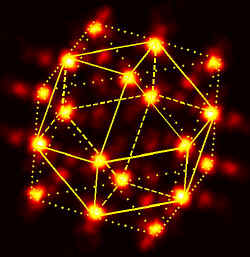Atomic Holograms

For most of this century physicists have looked for ways to peer inside solids and learn the positions of atoms. While techniques such as x-ray and neutron diffraction have been successful for many decades, they have their limits: They work best on large, high-quality crystals, which are hard to grow for many materials and impossible for others. And diffraction methods record only the intensity of scattered radiation, not the phase, which adds an additional layer of complexity to many experiments. The 14 June PRL describes progress in x-ray holography, a technique developed over the past few years that might overcome these limitations. Using x-ray holography, researchers hope to probe samples such as proteins and imperfect crystals which are difficult or impossible to study by more traditional methods.
Since shorter wavelengths of radiation can resolve correspondingly smaller objects, researchers recently developed a way to exploit x-rays to make holograms at the atomic scale. Atoms in a solid are excited by an x-ray beam to emit x rays; some of these x rays reach a detector directly, while others first scatter off nearby atoms. The hologram is the interference pattern between those two beams, and it shows the positions of the atoms in three dimensions.
The early x-ray holograms suffered from several technical problems, especially the difficulty of separating the weak x-ray scattering signal from the background. To get good data, the earlier holograms made with laboratory x-ray sources took as long as 40 days to record. Another problem was that the resolution of the hologram in some directions was poor because of the inability to measure x-rays coming out of the sample in all directions.
Now Miklos Tegze, of the Research Institute for Solid State Physics in Hungary, and his colleagues have overcome some of these problems. They improved the signal quality by using a synchrotron x-ray source, which provides a stronger beam, and by building a special graphite x-ray analyzer. The analyzer could tolerate the high intensity x rays from the synchrotron, and it had very high energy resolution, so compared with previous instruments, it could more easily discriminate “signal” x rays at a specific energy from the barrage of “background” x rays at other energies. This allowed the team to get a hologram of a cobalt oxide crystal in hours instead of days. To get equally good resolution in all directions, the researchers figured out the symmetry of the crystal from their measurements and used that knowledge to fill in the blanks in the angles that could not be measured. They determined the atomic positions of cobalt atoms to within 0.1 Å.
“The group has really produced by far the best images achieved to date,” says Charles Fadley of the University of California at Davis and the Lawrence Berkeley National Laboratory. Abraham Szoke, a pioneer of x-ray holography at the Lawrence Livermore National Laboratory, agrees: “They did a beautiful job; the experiments are exquisite.” But they also point out that the technique has a long way to go before it can help unravel the structures of interesting materials, like proteins. “I don’t think this is the end of the road,” says Szoke, but to get x-ray holography to work well is now “more of a technical problem than a physics problem,” says Fadley.
–Meher Antia
Meher Antia is a freelance science writer.


